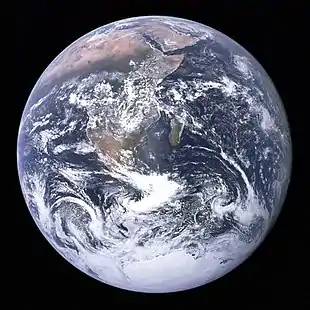Gravity of Earth
The gravity of Earth, denoted by g, is the net acceleration that is imparted to objects due to the combined effect of gravitation (from mass distribution within Earth) and the centrifugal force (from the Earth's rotation).[2][3]
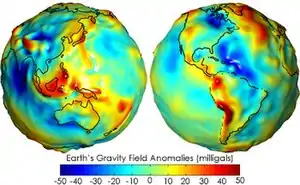
In SI units this acceleration is measured in metres per second squared (in symbols, m/s2 or m·s−2) or equivalently in newtons per kilogram (N/kg or N·kg−1). Near Earth's surface, gravitational acceleration is approximately 9.81 m/s2, which means that, ignoring the effects of air resistance, the speed of an object falling freely will increase by about 9.81 metres per second every second. This quantity is sometimes referred to informally as little g (in contrast, the gravitational constant G is referred to as big G).
The precise strength of Earth's gravity varies depending on location. The nominal "average" value at Earth's surface, known as standard gravity is, by definition, 9.80665 m/s2.[4] This quantity is denoted variously as gn, ge (though this sometimes means the normal equatorial value on Earth, 9.78033 m/s2), g0, gee, or simply g (which is also used for the variable local value).
The weight of an object on Earth's surface is the downwards force on that object, given by Newton's second law of motion, or F = ma (force = mass × acceleration). Gravitational acceleration contributes to the total gravity acceleration, but other factors, such as the rotation of Earth, also contribute, and, therefore, affect the weight of the object. Gravity does not normally include the gravitational pull of the Moon and Sun, which are accounted for in terms of tidal effects. It is a vector (physics) quantity, and its direction coincides with a plumb bob.
Variation in magnitude
A non-rotating perfect sphere of uniform mass density, or whose density varies solely with distance from the centre (spherical symmetry), would produce a gravitational field of uniform magnitude at all points on its surface. The Earth is rotating and is also not spherically symmetric; rather, it is slightly flatter at the poles while bulging at the Equator: an oblate spheroid. There are consequently slight deviations in the magnitude of gravity across its surface.
Gravity on the Earth's surface varies by around 0.7%, from 9.7639 m/s2 on the Nevado Huascarán mountain in Peru to 9.8337 m/s2 at the surface of the Arctic Ocean.[5] In large cities, it ranges from 9.7806[6] in Kuala Lumpur, Mexico City, and Singapore to 9.825 in Oslo and Helsinki.
Conventional value
In 1901 the third General Conference on Weights and Measures defined a standard gravitational acceleration for the surface of the Earth: gn = 9.80665 m/s2. It was based on measurements done at the Pavillon de Breteuil near Paris in 1888, with a theoretical correction applied in order to convert to a latitude of 45° at sea level.[7] This definition is thus not a value of any particular place or carefully worked out average, but an agreement for a value to use if a better actual local value is not known or not important.[8] It is also used to define the units kilogram force and pound force.
Latitude

The surface of the Earth is rotating, so it is not an inertial frame of reference. At latitudes nearer the Equator, the outward centrifugal force produced by Earth's rotation is larger than at polar latitudes. This counteracts the Earth's gravity to a small degree – up to a maximum of 0.3% at the Equator – and reduces the apparent downward acceleration of falling objects.
The second major reason for the difference in gravity at different latitudes is that the Earth's equatorial bulge (itself also caused by centrifugal force from rotation) causes objects at the Equator to be farther from the planet's centre than objects at the poles. Because the force due to gravitational attraction between two bodies (the Earth and the object being weighed) varies inversely with the square of the distance between them, an object at the Equator experiences a weaker gravitational pull than an object at the poles.
In combination, the equatorial bulge and the effects of the surface centrifugal force due to rotation mean that sea-level gravity increases from about 9.780 m/s2 at the Equator to about 9.832 m/s2 at the poles, so an object will weigh approximately 0.5% more at the poles than at the Equator.[2][9]
Altitude
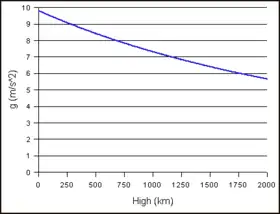
Gravity decreases with altitude as one rises above the Earth's surface because greater altitude means greater distance from the Earth's centre. All other things being equal, an increase in altitude from sea level to 9,000 metres (30,000 ft) causes a weight decrease of about 0.29%. (An additional factor affecting apparent weight is the decrease in air density at altitude, which lessens an object's buoyancy.[10] This would increase a person's apparent weight at an altitude of 9,000 metres by about 0.08%)
It is a common misconception that astronauts in orbit are weightless because they have flown high enough to escape the Earth's gravity. In fact, at an altitude of 400 kilometres (250 mi), equivalent to a typical orbit of the ISS, gravity is still nearly 90% as strong as at the Earth's surface. Weightlessness actually occurs because orbiting objects are in free-fall.[11]
The effect of ground elevation depends on the density of the ground (see Slab correction section). A person flying at 9,100 m (30,000 ft) above sea level over mountains will feel more gravity than someone at the same elevation but over the sea. However, a person standing on the Earth's surface feels less gravity when the elevation is higher.
The following formula approximates the Earth's gravity variation with altitude:
Where
- gh is the gravitational acceleration at height h above sea level.
- Re is the Earth's mean radius.
- g0 is the standard gravitational acceleration.
The formula treats the Earth as a perfect sphere with a radially symmetric distribution of mass; a more accurate mathematical treatment is discussed below.
Depth
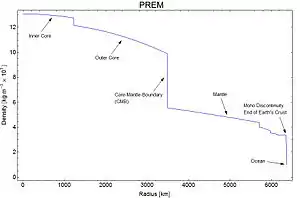
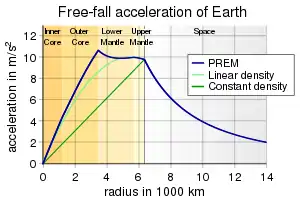
An approximate value for gravity at a distance r from the center of the Earth can be obtained by assuming that the Earth's density is spherically symmetric. The gravity depends only on the mass inside the sphere of radius r. All the contributions from outside cancel out as a consequence of the inverse-square law of gravitation. Another consequence is that the gravity is the same as if all the mass were concentrated at the center. Thus, the gravitational acceleration at this radius is[13]
where G is the gravitational constant and M(r) is the total mass enclosed within radius r. If the Earth had a constant density ρ, the mass would be M(r) = (4/3)πρr3 and the dependence of gravity on depth would be
The gravity g' at depth d is given by g'=g(1-d/R) where g is acceleration due to gravity on the surface of the Earth, d is depth and R is the radius of the Earth. If the density decreased linearly with increasing radius from a density ρ0 at the center to ρ1 at the surface, then ρ(r) = ρ0 − (ρ0 − ρ1) r / re, and the dependence would be
The actual depth dependence of density and gravity, inferred from seismic travel times (see Adams–Williamson equation), is shown in the graphs below.
Local topography and geology
Local differences in topography (such as the presence of mountains), geology (such as the density of rocks in the vicinity), and deeper tectonic structure cause local and regional differences in the Earth's gravitational field, known as gravitational anomalies.[14] Some of these anomalies can be very extensive, resulting in bulges in sea level, and throwing pendulum clocks out of synchronisation.
The study of these anomalies forms the basis of gravitational geophysics. The fluctuations are measured with highly sensitive gravimeters, the effect of topography and other known factors is subtracted, and from the resulting data conclusions are drawn. Such techniques are now used by prospectors to find oil and mineral deposits. Denser rocks (often containing mineral ores) cause higher than normal local gravitational fields on the Earth's surface. Less dense sedimentary rocks cause the opposite.
Other factors
In air or water, objects experience a supporting buoyancy force which reduces the apparent strength of gravity (as measured by an object's weight). The magnitude of the effect depends on the air density (and hence air pressure) or the water density respectively; see Apparent weight for details.
The gravitational effects of the Moon and the Sun (also the cause of the tides) have a very small effect on the apparent strength of Earth's gravity, depending on their relative positions; typical variations are 2 µm/s2 (0.2 mGal) over the course of a day.
Direction
Gravity acceleration is a vector quantity, with direction in addition to magnitude. In a spherically symmetric Earth, gravity would point directly towards the sphere's centre. As the Earth's figure is slightly flatter, there are consequently significant deviations in the direction of gravity: essentially the difference between geodetic latitude and geocentric latitude. Smaller deviations, called vertical deflection, are caused by local mass anomalies, such as mountains.
Comparative values worldwide
Tools exist for calculating the strength of gravity at various cities around the world.[15] The effect of latitude can be clearly seen with gravity in high-latitude cities: Anchorage (9.826 m/s2), Helsinki (9.825 m/s2), being about 0.5% greater than that in cities near the equator: Kuala Lumpur (9.776 m/s2), Manila (9.780 m/s2). The effect of altitude can be seen in Mexico City (9.776 m/s2; altitude 2,240 metres (7,350 ft)), and by comparing Denver (9.798 m/s2; 1,616 metres (5,302 ft)) with Washington, D.C. (9.801 m/s2; 30 metres (98 ft)), both of which are near 39° N. Measured values can be obtained from Physical and Mathematical Tables by T.M. Yarwood and F. Castle, Macmillan, revised edition 1970.[16]
| Location | m/s2 | ft/s2 | Location | m/s2 | ft/s2 | Location | m/s2 | ft/s2 | ||
|---|---|---|---|---|---|---|---|---|---|---|
| Amsterdam | 9.817 | 32.21 | Jakarta | 9.777 | 32.08 | Ottawa | 9.806 | 32.17 | ||
| Anchorage | 9.826 | 32.24 | Kandy | 9.775 | 32.07 | Paris | 9.809 | 32.18 | ||
| Athens | 9.800 | 32.15 | Kolkata | 9.785 | 32.10 | Perth | 9.794 | 32.13 | ||
| Auckland | 9.799 | 32.15 | Kuala Lumpur | 9.776 | 32.07 | Rio de Janeiro | 9.788 | 32.11 | ||
| Bangkok | 9.780 | 32.09 | Kuwait City | 9.792 | 32.13 | Rome | 9.803 | 32.16 | ||
| Birmingham | 9.817 | 32.21 | Lisbon | 9.801 | 32.16 | Seattle | 9.811 | 32.19 | ||
| Brussels | 9.815 | 32.20 | London | 9.816 | 32.20 | Singapore | 9.776 | 32.07 | ||
| Buenos Aires | 9.797 | 32.14 | Los Angeles | 9.796 | 32.14 | Skopje | 9.804 | 32.17 | ||
| Cape Town | 9.796 | 32.14 | Madrid | 9.800 | 32.15 | Stockholm | 9.818 | 32.21 | ||
| Chicago | 9.804 | 32.17 | Manchester | 9.818 | 32.21 | Sydney | 9.797 | 32.14 | ||
| Copenhagen | 9.821 | 32.22 | Manila | 9.780 | 32.09 | Taipei | 9.790 | 32.12 | ||
| Denver | 9.798 | 32.15 | Melbourne | 9.800 | 32.15 | Tokyo | 9.798 | 32.15 | ||
| Frankfurt | 9.814 | 32.20 | Mexico City | 9.776 | 32.07 | Toronto | 9.807 | 32.18 | ||
| Havana | 9.786 | 32.11 | Montréal | 9.809 | 32.18 | Vancouver | 9.809 | 32.18 | ||
| Helsinki | 9.825 | 32.23 | New York City | 9.802 | 32.16 | Washington, D.C. | 9.801 | 32.16 | ||
| Hong Kong | 9.785 | 32.10 | Nicosia | 9.797 | 32.14 | Wellington | 9.803 | 32.16 | ||
| Istanbul | 9.808 | 32.18 | Oslo | 9.825 | 32.23 | Zurich | 9.807 | 32.18 |
Mathematical models
Latitude model
If the terrain is at sea level, we can estimate , the acceleration at latitude :
- .
This is the International Gravity Formula 1967, the 1967 Geodetic Reference System Formula, Helmert's equation or Clairaut's formula.[17]
An alternative formula for g as a function of latitude is the WGS (World Geodetic System) 84 Ellipsoidal Gravity Formula:[18]
where,
- are the equatorial and polar semi-axes, respectively;
- is the spheroid's eccentricity, squared;
- is the defined gravity at the equator and poles, respectively;
- (formula constant);
then, where ,[18]
- .
where the semi-axes of the earth are:
The difference between the WGS-84 formula and Helmert's equation is less than 0.68 μm·s−2.
Free air correction
The first correction to be applied to the model is the free air correction (FAC) that accounts for heights above sea level. Near the surface of the Earth (sea level), gravity decreases with height such that linear extrapolation would give zero gravity at a height of one half of the Earth's radius - (9.8 m·s−2 per 3,200 km.)[19]
Using the mass and radius of the Earth:
The FAC correction factor (Δg) can be derived from the definition of the acceleration due to gravity in terms of G, the gravitational constant (see estimating g from the law of universal gravitation, below):
At a height h above the nominal surface of the Earth gh is given by:
So the FAC for a height h above the nominal Earth radius can be expressed:
This expression can be readily used for programming or inclusion in a spreadsheet. Collecting terms, simplifying and neglecting small terms (h ≪ rEarth), however yields the good approximation:
Using the numerical values above and for a height h in metres:
Grouping the latitude and FAC altitude factors the expression most commonly found in the literature is:
where is acceleration in m·s−2 at latitude and altitude h in metres.
Slab correction
- Note: The section uses the galileo (symbol: "Gal"), which is a cgs unit for acceleration of 1 centimetre/second2.
For flat terrain above sea level a second term is added for the gravity due to the extra mass; for this purpose the extra mass can be approximated by an infinite horizontal slab, and we get 2πG times the mass per unit area, i.e. 4.2×10−10 m3·s−2·kg−1 (0.042 μGal·kg−1·m2) (the Bouguer correction). For a mean rock density of 2.67 g·cm−3 this gives 1.1×10−6 s−2 (0.11 mGal·m−1). Combined with the free-air correction this means a reduction of gravity at the surface of ca. 2 µm·s−2 (0.20 mGal) for every metre of elevation of the terrain. (The two effects would cancel at a surface rock density of 4/3 times the average density of the whole Earth. The density of the whole Earth is 5.515 g·cm−3, so standing on a slab of something like iron whose density is over 7.35 g·cm−3 would increase one's weight.)
For the gravity below the surface we have to apply the free-air correction as well as a double Bouguer correction. With the infinite slab model this is because moving the point of observation below the slab changes the gravity due to it to its opposite. Alternatively, we can consider a spherically symmetrical Earth and subtract from the mass of the Earth that of the shell outside the point of observation, because that does not cause gravity inside. This gives the same result.
Estimating g from the law of universal gravitation
From the law of universal gravitation, the force on a body acted upon by Earth's gravity is given by
where r is the distance between the centre of the Earth and the body (see below), and here we take m1 to be the mass of the Earth and m2 to be the mass of the body.
Additionally, Newton's second law, F = ma, where m is mass and a is acceleration, here tells us that
Comparing the two formulas it is seen that:
So, to find the acceleration due to gravity at sea level, substitute the values of the gravitational constant, G, the Earth's mass (in kilograms), m1, and the Earth's radius (in metres), r, to obtain the value of g:
This formula only works because of the mathematical fact that the gravity of a uniform spherical body, as measured on or above its surface, is the same as if all its mass were concentrated at a point at its centre. This is what allows us to use the Earth's radius for r.
The value obtained agrees approximately with the measured value of g. The difference may be attributed to several factors, mentioned above under "Variations":
- The Earth is not homogeneous
- The Earth is not a perfect sphere, and an average value must be used for its radius
- This calculated value of g only includes true gravity. It does not include the reduction of constraint force that we perceive as a reduction of gravity due to the rotation of Earth, and some of gravity being counteracted by centrifugal force.
There are significant uncertainties in the values of r and m1 as used in this calculation, and the value of G is also rather difficult to measure precisely.
If G, g and r are known then a reverse calculation will give an estimate of the mass of the Earth. This method was used by Henry Cavendish.
Measurement
The measurement of Earth's gravity is called gravimetry.
Satellite techniques
Currently, the static and time-variable Earth's gravity field parameters are being determined using modern satellite missions, such as GOCE, CHAMP, Swarm, GRACE and GRACE-FO.[20][21] The lowest-degree parameters, including the Earth's oblateness and geocenter motion are best determined from Satellite laser ranging.[22]
See also
![]() Earth sciences portal
Earth sciences portal
References
- NASA/JPL/University of Texas Center for Space Research. "PIA12146: GRACE Global Gravity Animation". Photojournal. NASA Jet Propulsion Laboratory. Retrieved 30 December 2013.
- Boynton, Richard (2001). "Precise Measurement of Mass" (PDF). Sawe Paper No. 3147. Arlington, Texas: S.A.W.E., Inc. Retrieved 2007-01-21.
- Hofmann-Wellenhof, B.; Moritz, H. (2006). Physical Geodesy (2nd ed.). Springer. ISBN 978-3-211-33544-4. § 2.1: “The total force acting on a body at rest on the earth’s surface is the resultant of gravitational force and the centrifugal force of the earth’s rotation and is called gravity.”
- Taylor, Barry N.; Thompson, Ambler, eds. (March 2008). The international system of units (SI) (PDF) (Report). National Institute of Standards and Technology. p. 52. NIST special publication 330, 2008 edition.
- Hirt, Christian; Claessens, Sten; Fecher, Thomas; Kuhn, Michael; Pail, Roland; Rexer, Moritz (August 28, 2013). "New ultrahigh-resolution picture of Earth's gravity field". Geophysical Research Letters. 40 (16): 4279–4283. Bibcode:2013GeoRL..40.4279H. doi:10.1002/grl.50838. hdl:20.500.11937/46786.
- "Wolfram|Alpha Gravity in Kuala Lumpur", Wolfram Alpha, accessed November 2020
- Terry Quinn (2011). From Artefacts to Atoms: The BIPM and the Search for Ultimate Measurement Standards. Oxford University Press. p. 127. ISBN 978-0-19-530786-3.
- Resolution of the 3rd CGPM (1901), page 70 (in cm/s2). BIPM – Resolution of the 3rd CGPM
- "Curious About Astronomy?", Cornell University, retrieved June 2007
- "I feel 'lighter' when up a mountain but am I?", National Physical Laboratory FAQ
- "The G's in the Machine", NASA, see "Editor's note #2"
- A. M. Dziewonski, D. L. Anderson (1981). "Preliminary reference Earth model" (PDF). Physics of the Earth and Planetary Interiors. 25 (4): 297–356. Bibcode:1981PEPI...25..297D. doi:10.1016/0031-9201(81)90046-7. ISSN 0031-9201.
- Tipler, Paul A. (1999). Physics for scientists and engineers (4th ed.). New York: W.H. Freeman/Worth Publishers. pp. 336–337. ISBN 9781572594913.
- Watts, A. B.; Daly, S. F. (May 1981). "Long wavelength gravity and topography anomalies". Annual Review of Earth and Planetary Sciences. 9: 415–418. Bibcode:1981AREPS...9..415W. doi:10.1146/annurev.ea.09.050181.002215.
- Gravitational Fields Widget as of Oct 25th, 2012 – WolframAlpha
- T.M. Yarwood and F. Castle, Physical and Mathematical Tables, revised edition, Macmillan and Co LTD, London and Basingstoke, Printed in Great Britain by The University Press, Glasgow, 1970, pp 22 & 23.
- International Gravity formula Archived 2008-08-20 at the Wayback Machine
- Department of Defense World Geodetic System 1984 ― Its Definition and Relationships with Local Geodetic Systems,NIMA TR8350.2, 3rd ed., Tbl. 3.4, Eq. 4-1
- The rate of decrease is calculated by differentiating g(r) with respect to r and evaluating at r=rEarth.
- Meyer, Ulrich; Sosnica, Krzysztof; Arnold, Daniel; Dahle, Christoph; Thaller, Daniela; Dach, Rolf; Jäggi, Adrian (22 April 2019). "SLR, GRACE and Swarm Gravity Field Determination and Combination". Remote Sensing. 11 (8): 956. Bibcode:2019RemS...11..956M. doi:10.3390/rs11080956.
- Tapley, Byron D.; Watkins, Michael M.; Flechtner, Frank; Reigber, Christoph; Bettadpur, Srinivas; Rodell, Matthew; Sasgen, Ingo; Famiglietti, James S.; Landerer, Felix W.; Chambers, Don P.; Reager, John T.; Gardner, Alex S.; Save, Himanshu; Ivins, Erik R.; Swenson, Sean C.; Boening, Carmen; Dahle, Christoph; Wiese, David N.; Dobslaw, Henryk; Tamisiea, Mark E.; Velicogna, Isabella (May 2019). "Contributions of GRACE to understanding climate change". Nature Climate Change. 9 (5): 358–369. Bibcode:2019NatCC...9..358T. doi:10.1038/s41558-019-0456-2. PMC 6750016. PMID 31534490.
- Sośnica, Krzysztof; Jäggi, Adrian; Meyer, Ulrich; Thaller, Daniela; Beutler, Gerhard; Arnold, Daniel; Dach, Rolf (October 2015). "Time variable Earth's gravity field from SLR satellites". Journal of Geodesy. 89 (10): 945–960. Bibcode:2015JGeod..89..945S. doi:10.1007/s00190-015-0825-1.
